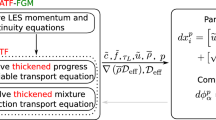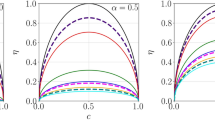Abstract
A stochastic implementation of the Multiple Mapping Conditioning (MMC) approach has been applied to a turbulent piloted jet diffusion flame (Sandia flame F) that is close to extinction. Two classic mixing models (Curl’s and IEM) are introduced in the MMC context to model the turbulent mixing. The suggested model involves the use of a reference space (that is mapped to mixture fraction space) in order to define particle proximity. The addition of the MMC ideas to the IEM and Curl’s models, that is suggested in the current work, aspires to combine the simplicity of these two models with the enforced compositional locality without violating the linearity and independence principles. The formulation of the approach is discussed in detail and results are presented for the mixing field and reactive species. The predictions are compared with joint-scalar PDF simulations using the same mixing models and experimental data. Moreover, the sensitivity of the model to the particle number is examined. It is shown that MMC is less sensitive to the number of particles and can generally produce improved predictions of major and minor chemically reacting species with a lower number of particles.
Similar content being viewed by others
References
Barlow, R., Frank, J.: Effects of turbulence on species mass fractions in methane/air jet flames. Proc. Combust Inst 27, 1087–1095 (1998)
Barlow, R., Frank, J., Karpetis, A., Chen, J.Y.: Piloted methane/air jet flames: Transport effects and aspects of scalar structure. Combust. Flame 143, 433–449 (2005)
Cao, R., Pope, S.: The influence of chemical mechanisms on pdf calculations of nonpremixed piloted jet flames. Combust. Flame 143, 450–470 (2005)
Cao, R., Wang, H., Pope, S.: The effect of mixing models in pdf calculations of piloted jet flames. Proc. Combust Inst 31, 15431550 (2007)
Chen, H., Chen, S., Kraichnan, R.: Probability distribution of a stochastically advected scalar field. Phys. Rev. Lett. 63(24), 2657–60 (1989)
Sung, C.J., Law, C., Chen, J.: Augmented reduced mechanisms for no emission in methane oxidation. Combust. Flame 125(1–2), 906–919 (2001)
Cleary, M., Kronenburg, A.: Hybrid multiple mapping conditioning on passive and reactive scalars. Combust. Flame 151(4), 623–638 (2007)
Corrsin, S.: J. Aeronaut. Sci. 18, 417 (1951)
Curl, R., Miller, R., Ralph, J., Towell, G.: Dispersed phase mixing: Ii. measurements in organic dispersed systems. AIChE J. 9, 175–181 (1963)
Dopazo, C.: Probability density function approach for a turbulent heated jet. centerline evolution. Phys. Fluids 18, 397–404 (1975)
Gardiner, C.: Handbook of stochastic methods. Springer, New York (1984)
Ge, Y., Cleary, M., Klimenko, A.: Sparse-lagrangian {FDF} simulations of sandia flame e with density coupling. Proc. Combust. Inst. 33(1), 1401–1409 (2011)
Ge, Y., Cleary, M., Klimenko, A.: A comparative study of sandia flame series (df) using sparse-lagrangian {MMC} modelling. Proc. Combust. Inst. 34(1), 1325–1332 (2013)
Haworth, D.: Progress in probability density function methods for turbulent reacting flows. Prog. Energy Combust. Sci. 36, 168259 (2010)
He, G.W., Zhang, Z.F.: Two-point closure strategy in the mapping closure approximation approach. Phys. Rev. E 70(036), 309 (2004)
Janicka, J., Kolbe, W., Kollmann, W.: Closure of the transport equation for the probability density function of turbulent scalar fields. J. Nonequil. Thermodyn 4, 47–66 (1979)
Klimenko, A.: Modern modelling of turbulent non-premixed combustion and reaction of pollution emission. Proceedings of Clean Air VII, Lisbon, Portugal (2003)
Klimenko, A: Matching the conditional variance as a criterion for selecting parameters in the simplest multiple mapping conditioning models. Phys. Fluids 16(12), 4754–4757 (2004)
Klimenko, A.: On simulating scalar transport by mixing between lagrangian particles. Phys. Fluids 19(3), 31,702 (2007)
Klimenko, A., Bilger, R.: Conditional moment closure for turbulent combustion. Prog. Energy Combust. Sci 25(6), 595–687 (1999)
Klimenko, A., Pope, S.: The modeling of turbulent reactive flows based on multiple mapping conditioning. Phys. Fluids 15(7), 1907–1925 (2003)
Kronenburg, A., Cleary, M.J.: Multiple mapping conditioning for flames with partial premixing. Combust. Flame 155, 215–231 (2008)
Launder, B., Spalding, D.: The numerical computation of turbulent flows. Comput. Methods Appl. Mech. Eng. 3(2), 269–289 (1974)
Lindstedt, R., Louloudi, S., Vaos, E.M.: Joint scalar probability density function modeling of pollutant formation in piloted turbulent jet diffusion flames with comprehensive chemistry. Proc. Combust Inst 28(1), 149156 (2000)
Muradoglu, M., Jenny, P., Pope, S.B., Caughey, D.A.: A consistent hybrid finite-volume/particle method for the pdf equations of turbulent reactive flows. J. Comp. Phys. 154, 342371 (1999)
Norris, A., Pope, S.: Turbulent mixing model based on ordering pairing. Combust. Flame 83(1–2), 27–42 (1991)
Pope, S.: PDF methods for turbulent reactive flows. Prog. Energy Combust. Sci. 11(2), 119–192 (1985)
Pope, S.: Mapping closures for turbulent mixing and reaction. Theor. Comput. Fluid Dyn 2(5–6), 255–70 (1991)
Pope, S.B.: A model for turbulent mixing based on shadow-position conditioning. Phys. Fluids 25(11) (2013)
Raman, V., Pitsch, H.: A consistent les/filtered-density function formulation for the simulation of turbulent flames with detailed chemistry. Proc Combust Inst 31, 1711–1719 (2007)
Subramaniam, S., Pope, S.: A mixing model for turbulent reactive flows based on euclidean minimum spanning trees. Combust. Flame 115(4), 487–514 (1999)
Vogiatzaki, K., Cleary, M., Kronenburg, A., Kent, J.: Modeling of scalar mixing in turbulent jet flames by multiple mapping conditioning. Phys. Fluids 21(2) (2009)
Vogiatzaki, K., Kronenburg, A., Navarro-Martinez, S., Jones, W.: Stochastic multiple mapping conditioning for a piloted, turbulent jet diffusion flame. Proc. Combust Inst 33(1), 1523–1531 (2011)
Wandel, A., Klimenko, A.: Testing multiple mapping conditioning mixing for monte carlo probability density function simulations. Phys. Fluids 17(12), 128,105 (2005)
Wandel, A.P., Lindstedt, R.P.: Hybrid multiple mapping conditioning modeling of local extinction. Proc. Combust. Inst. 34(1), 1365–1372 (2013)
Xu, J., Pope, S.B.: Pdf calculations of turbulent nonpremixed flames with local extinction. Combust. Flame 123(3), 281–307 (2000)
Author information
Authors and Affiliations
Corresponding author
Rights and permissions
About this article
Cite this article
Vogiatzaki, K., Navarro-Martinez, S., De, S. et al. Mixing Modelling Framework Based on Multiple Mapping Conditioning for the Prediction of Turbulent Flame Extinction. Flow Turbulence Combust 95, 501–517 (2015). https://doi.org/10.1007/s10494-015-9626-0
Received:
Accepted:
Published:
Issue Date:
DOI: https://doi.org/10.1007/s10494-015-9626-0




